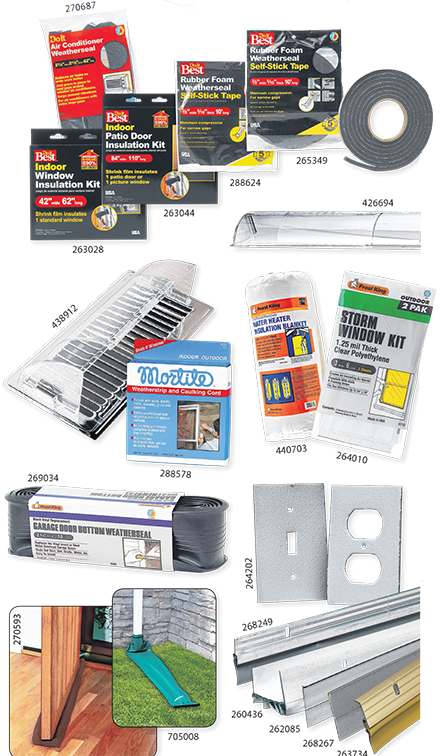Phillips Hardware Tips: Winterize Your Home
 You’ll get a season’s worth of savings and peace of mind by taking a few steps in the fall to get your home ready for cold weather.
You’ll get a season’s worth of savings and peace of mind by taking a few steps in the fall to get your home ready for cold weather.
Clean those gutters – Once the leaves fall, remove them and other debris from your home’s gutters – by hand, by scraper or spatula, and finally by a good hose rinse – so that winter’s rain and melting snow can drain. Clogged drains can form ice dams, in which water backs up, freezes and causes water to seep into the house, the Insurance Information Institute says. As you’re hosing out your gutters, look for leaks and misaligned pipes. Also, make sure the downspouts are carrying water away from the house’s foundation, where it could cause flooding or other water damage. The rule of thumb is that water should be at least 10 feet away from the house.
Block those leaks – One of the best ways to winterize your home is to simply block obvious leaks around your house. The average American home has leaks that amount to a nine-square-foot hole in the wall, according to EarthWorks Group. You have to find the leak so on a breezy day, walk around inside holding a lit incense stick to the most common drafty areas: recessed lighting, window and door frames, electrical outlets. You can buy door sweeps to close spaces under exterior doors, foam weather strip for around door frames, window seal kits for over old windows or caulk or apply tacky rope caulk to those drafty windows.
Check the furnace and change your thermostat – You should turn your furnace on now, to make sure it’s even working, before the cold weather descends. A strong, odd, short-lasting smell is natural when firing up the furnace in the autumn; simply open windows to dissipate it. But if the smell lasts a long time, shut down the furnace and call a professional. Throughout the winter you should change the furnace filters regularly (check them monthly). A dirty filter impedes air flow, reduces efficiency and could even cause a fire in an extreme case. A programmable thermostat will help you keep heating cost down this winter. Make sure to set it lower while you are at work and when you go to bed since you will be under blankets anyways.
Get your ducts in a row – According to the U.S. Department of Energy, a home with central heating can lose up to 60% of its heated air before that air reaches the vents if ductwork is not well-connected and insulated, or if it must travel through unheated spaces. That’s a huge amount of wasted money, not to mention a chilly house. Ducts aren’t always easy to see, but you can often find them exposed in the attic, the basement and crawlspaces. Repair places where pipes are pinched, which impedes flow of heated air to the house, and fix gaps with a metalbacked tape. Ducts also should be vacuumed once every few years, to clean out the abundant dust, animal hair and other gunk that can gather in them and cause respiratory problems.
Face your windows – Now, of course, is the time to take down the window screens and put up storm windows, which provide an extra layer of protection and warmth for the home. Storm windows are particularly helpful if you have old, single-pane glass windows. But if you don’t have storm windows, and your windows are leaky or drafty, buy a window insulator kit. Basically, the kit is plastic sheeting that’s affixed to a window’s interior with double-stick tape. A hair dryer is then used to shrink-wrap the sheeting onto the window. This is temporary and it’s not pretty, but it’s inexpensive and it’s extremely effective.
Reverse that fan – By reversing its direction from the summer operation, the fan will push warm air downward and force it to recirculate, keeping you more comfortable. Here’s how you know the fan is ready for winter: as you look up, the blades should be turning clockwise.
Wrap those pipes – A burst pipe caused by a winter freeze is a nightmare. Prevent it before Jack Frost sets his grip: Before freezing nights hit, make certain that the water to your hose bibs is shut off inside your house (via a turnoff valve), and that the lines are drained. Next, go looking for other pipes that aren’t insulated, or that pass through unheated spaces – pipes that run through crawlspaces, basements or garages. Wrap them with pre-molded foam rubber sleeves or fiberglass insulation. If you’re really worried about a pipe freezing, you can first wrap it with heating tape, which is basically an electrical cord that emits heat. Invest in a hot water jacket to help
Don’t forget your hot water heater – Just like insulating your walls or pipes, insulating your hot water tank is an easy and inexpensive way to improve energy efficiency and save you money each month. If your water tank is new, it is likely already insulated. If you have an older hot water tank, check to see if it has insulation with an R-value of at least 24. If not, consider insulating your water tank, which could reduce heat losses by 25%–45% and save you about 4%–9% in water heating costs. If you don’t know your water heater tank’s R-value, touch it. A tank that is warm to the touch needs additional insulation.
Finally, check those alarms – This is a great time to check the operation and change the batteries on your home’s smoke detectors. Detectors should be replaced every 10 years, fire officials say. Test them, older ones in particular, with a small bit of actual smoke, and not just by pressing the “test” button. Check to see that your fire extinguisher is still where it should be, and still works. Also, invest in a carbon-monoxide detector; every home should have at least one.

